Pitching and Negotiation Skills: Strategies for Business Growth
VerifiedAdded on 2024/04/26
|21
|3930
|256
Report
AI Summary
This report provides a comprehensive analysis of negotiation and pitching skills within a business context. It begins by defining negotiation, its purpose, and key stakeholders, then evaluates the essential steps and information needed for successful deals. The report delves into the RFP process, outlining required documentation and consequences of breaches, and critically evaluates competitive tendering and contract processes, offering recommendations for minimizing risk. Furthermore, it explores the development of effective pitches, examining ways to maximize success and assessing potential outcomes. Finally, the report addresses how organizations fulfill post-pitch obligations, identifying potential issues and recommending strategies for effective management, including risk mitigation. The document concludes by summarizing key findings and providing references for further study.
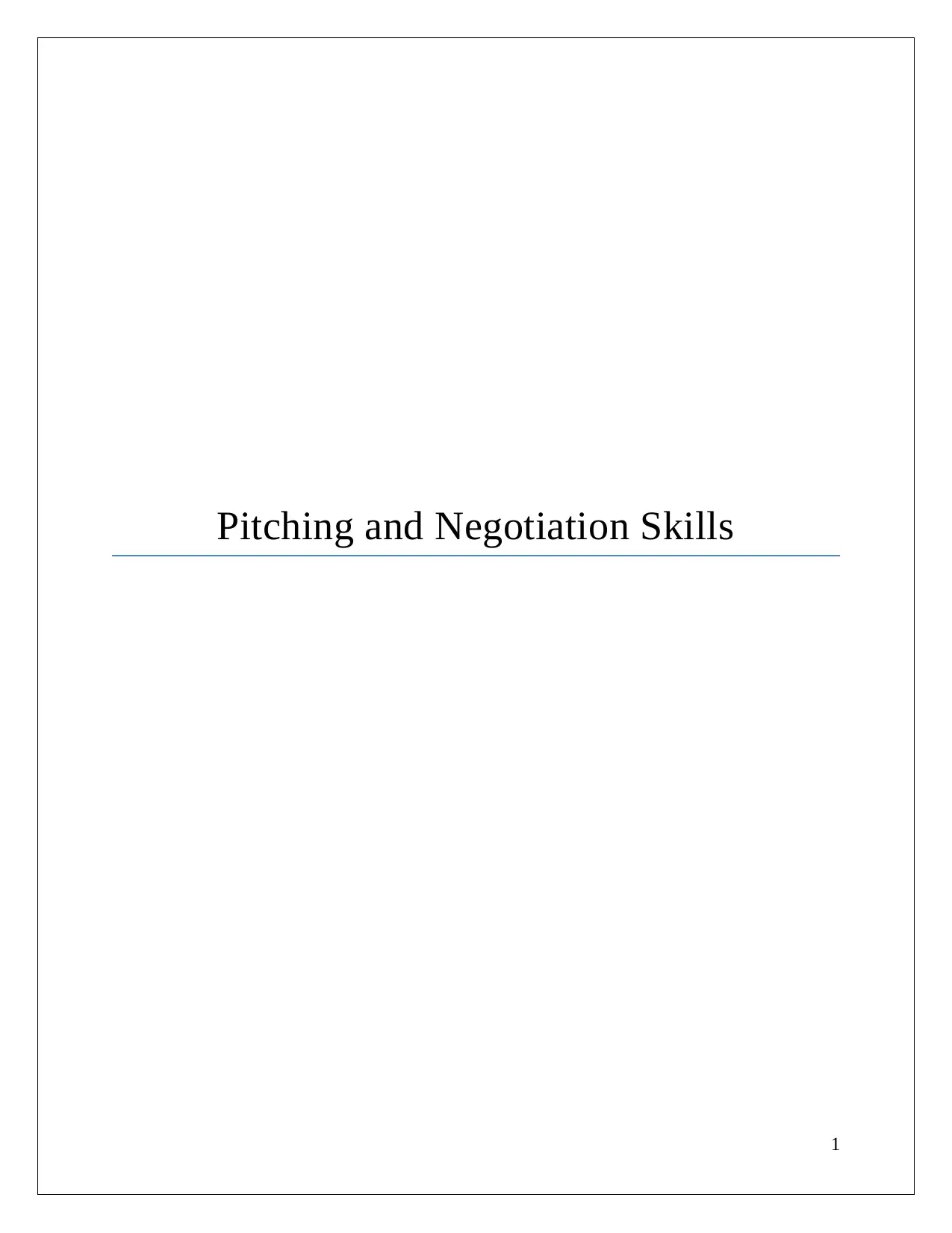
Pitching and Negotiation Skills
1
1
Paraphrase This Document
Need a fresh take? Get an instant paraphrase of this document with our AI Paraphraser
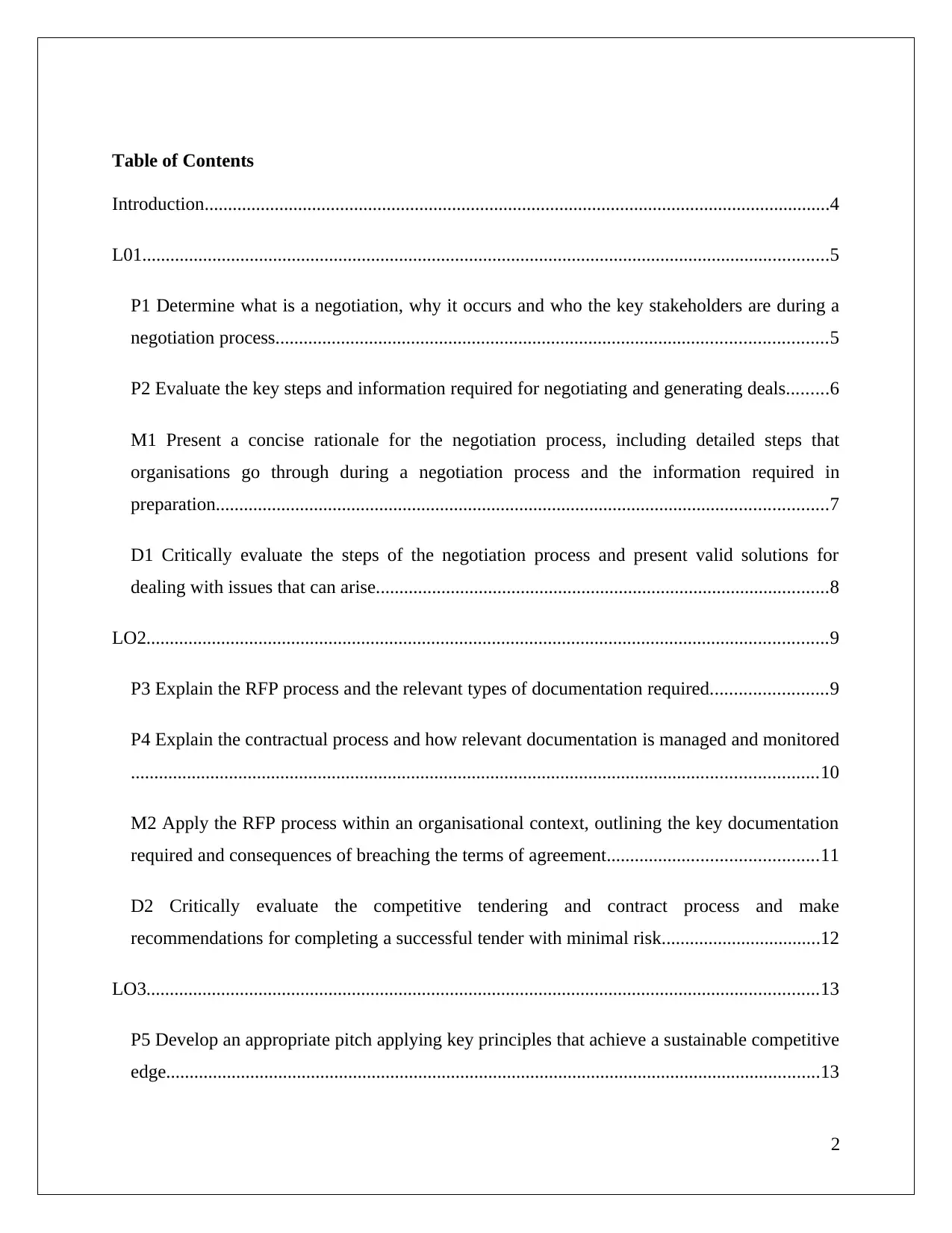
Table of Contents
Introduction......................................................................................................................................4
L01...................................................................................................................................................5
P1 Determine what is a negotiation, why it occurs and who the key stakeholders are during a
negotiation process......................................................................................................................5
P2 Evaluate the key steps and information required for negotiating and generating deals.........6
M1 Present a concise rationale for the negotiation process, including detailed steps that
organisations go through during a negotiation process and the information required in
preparation...................................................................................................................................7
D1 Critically evaluate the steps of the negotiation process and present valid solutions for
dealing with issues that can arise.................................................................................................8
LO2..................................................................................................................................................9
P3 Explain the RFP process and the relevant types of documentation required.........................9
P4 Explain the contractual process and how relevant documentation is managed and monitored
...................................................................................................................................................10
M2 Apply the RFP process within an organisational context, outlining the key documentation
required and consequences of breaching the terms of agreement.............................................11
D2 Critically evaluate the competitive tendering and contract process and make
recommendations for completing a successful tender with minimal risk..................................12
LO3................................................................................................................................................13
P5 Develop an appropriate pitch applying key principles that achieve a sustainable competitive
edge............................................................................................................................................13
2
Introduction......................................................................................................................................4
L01...................................................................................................................................................5
P1 Determine what is a negotiation, why it occurs and who the key stakeholders are during a
negotiation process......................................................................................................................5
P2 Evaluate the key steps and information required for negotiating and generating deals.........6
M1 Present a concise rationale for the negotiation process, including detailed steps that
organisations go through during a negotiation process and the information required in
preparation...................................................................................................................................7
D1 Critically evaluate the steps of the negotiation process and present valid solutions for
dealing with issues that can arise.................................................................................................8
LO2..................................................................................................................................................9
P3 Explain the RFP process and the relevant types of documentation required.........................9
P4 Explain the contractual process and how relevant documentation is managed and monitored
...................................................................................................................................................10
M2 Apply the RFP process within an organisational context, outlining the key documentation
required and consequences of breaching the terms of agreement.............................................11
D2 Critically evaluate the competitive tendering and contract process and make
recommendations for completing a successful tender with minimal risk..................................12
LO3................................................................................................................................................13
P5 Develop an appropriate pitch applying key principles that achieve a sustainable competitive
edge............................................................................................................................................13
2
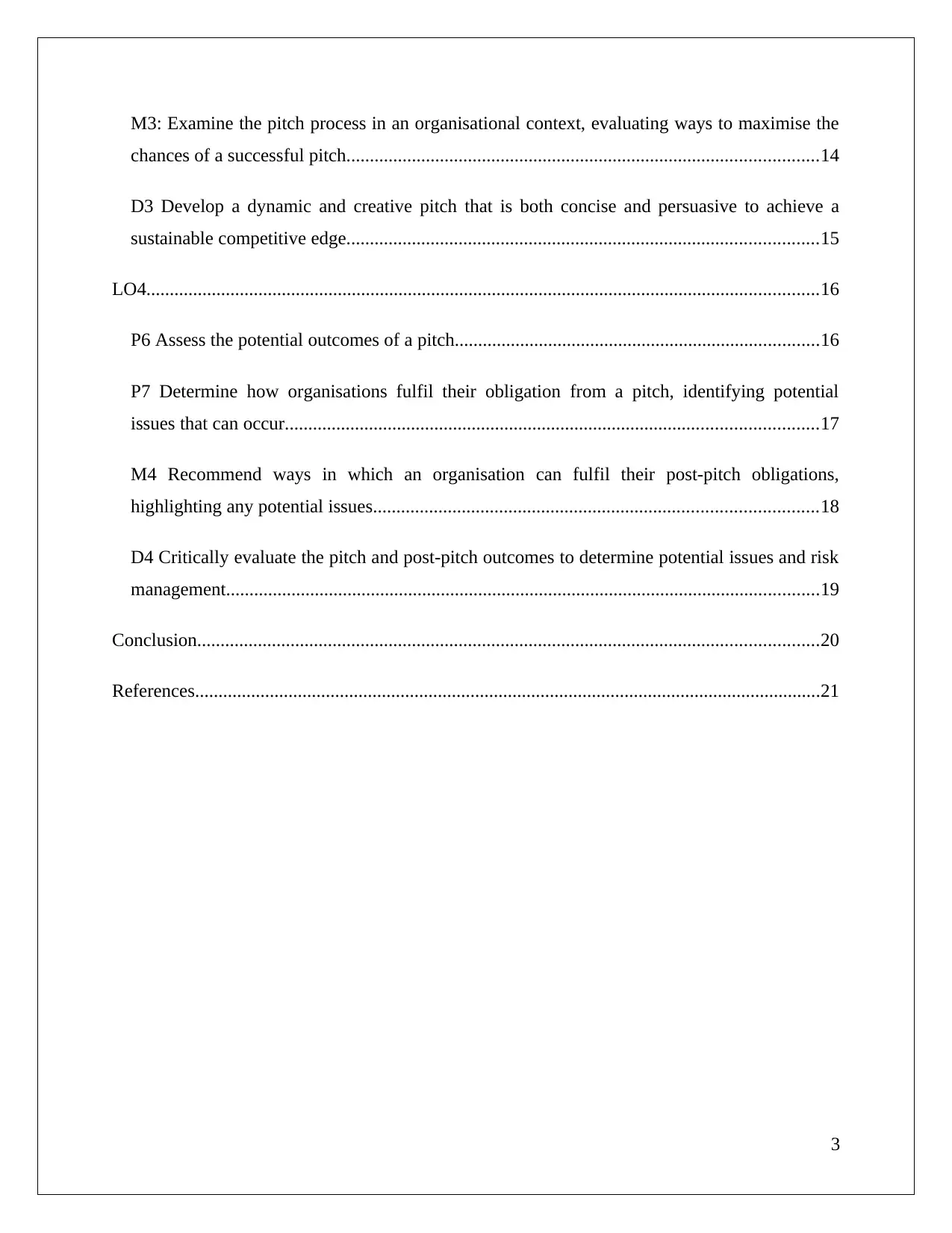
M3: Examine the pitch process in an organisational context, evaluating ways to maximise the
chances of a successful pitch.....................................................................................................14
D3 Develop a dynamic and creative pitch that is both concise and persuasive to achieve a
sustainable competitive edge.....................................................................................................15
LO4................................................................................................................................................16
P6 Assess the potential outcomes of a pitch..............................................................................16
P7 Determine how organisations fulfil their obligation from a pitch, identifying potential
issues that can occur..................................................................................................................17
M4 Recommend ways in which an organisation can fulfil their post-pitch obligations,
highlighting any potential issues...............................................................................................18
D4 Critically evaluate the pitch and post-pitch outcomes to determine potential issues and risk
management...............................................................................................................................19
Conclusion.....................................................................................................................................20
References......................................................................................................................................21
3
chances of a successful pitch.....................................................................................................14
D3 Develop a dynamic and creative pitch that is both concise and persuasive to achieve a
sustainable competitive edge.....................................................................................................15
LO4................................................................................................................................................16
P6 Assess the potential outcomes of a pitch..............................................................................16
P7 Determine how organisations fulfil their obligation from a pitch, identifying potential
issues that can occur..................................................................................................................17
M4 Recommend ways in which an organisation can fulfil their post-pitch obligations,
highlighting any potential issues...............................................................................................18
D4 Critically evaluate the pitch and post-pitch outcomes to determine potential issues and risk
management...............................................................................................................................19
Conclusion.....................................................................................................................................20
References......................................................................................................................................21
3
⊘ This is a preview!⊘
Do you want full access?
Subscribe today to unlock all pages.

Trusted by 1+ million students worldwide
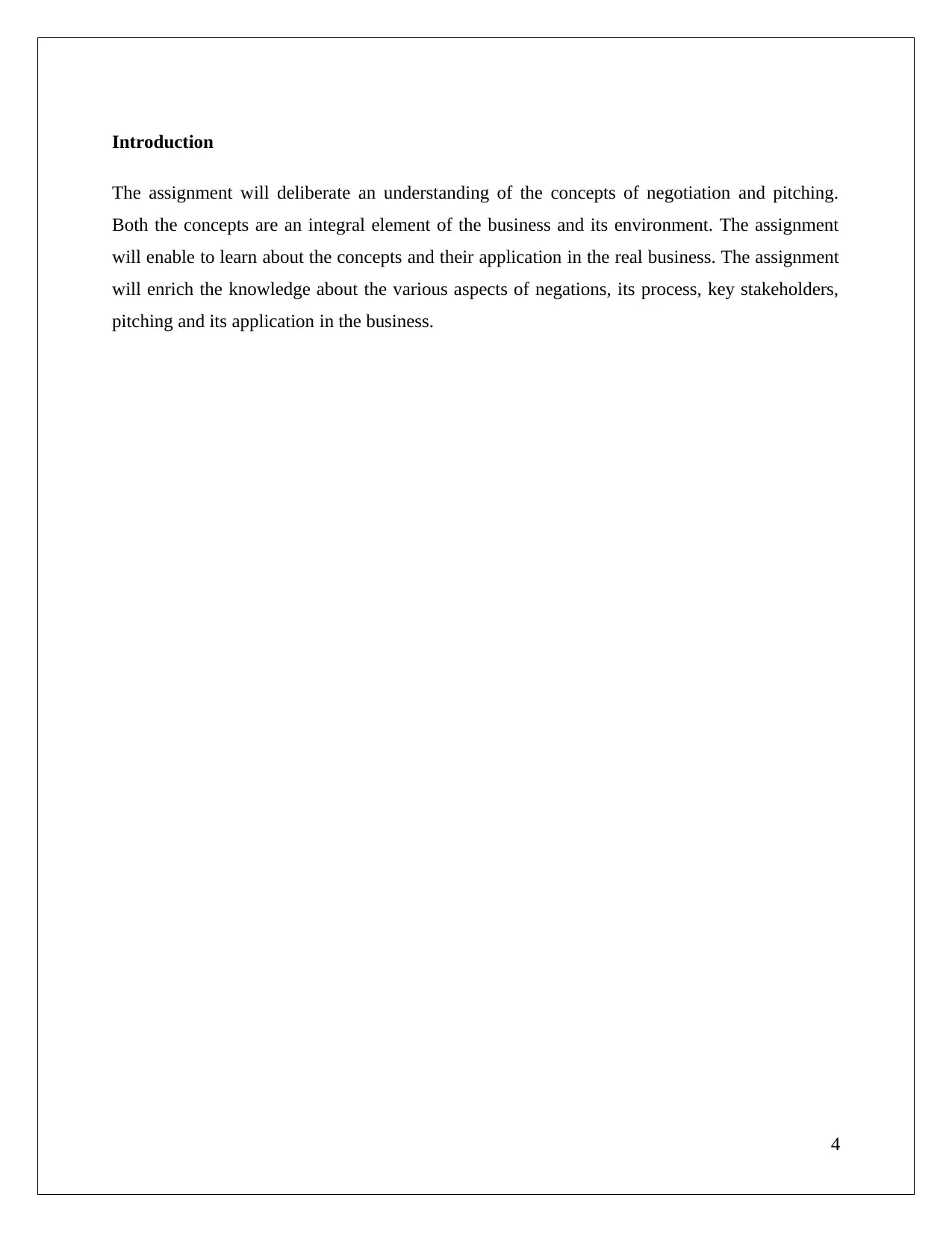
Introduction
The assignment will deliberate an understanding of the concepts of negotiation and pitching.
Both the concepts are an integral element of the business and its environment. The assignment
will enable to learn about the concepts and their application in the real business. The assignment
will enrich the knowledge about the various aspects of negations, its process, key stakeholders,
pitching and its application in the business.
4
The assignment will deliberate an understanding of the concepts of negotiation and pitching.
Both the concepts are an integral element of the business and its environment. The assignment
will enable to learn about the concepts and their application in the real business. The assignment
will enrich the knowledge about the various aspects of negations, its process, key stakeholders,
pitching and its application in the business.
4
Paraphrase This Document
Need a fresh take? Get an instant paraphrase of this document with our AI Paraphraser
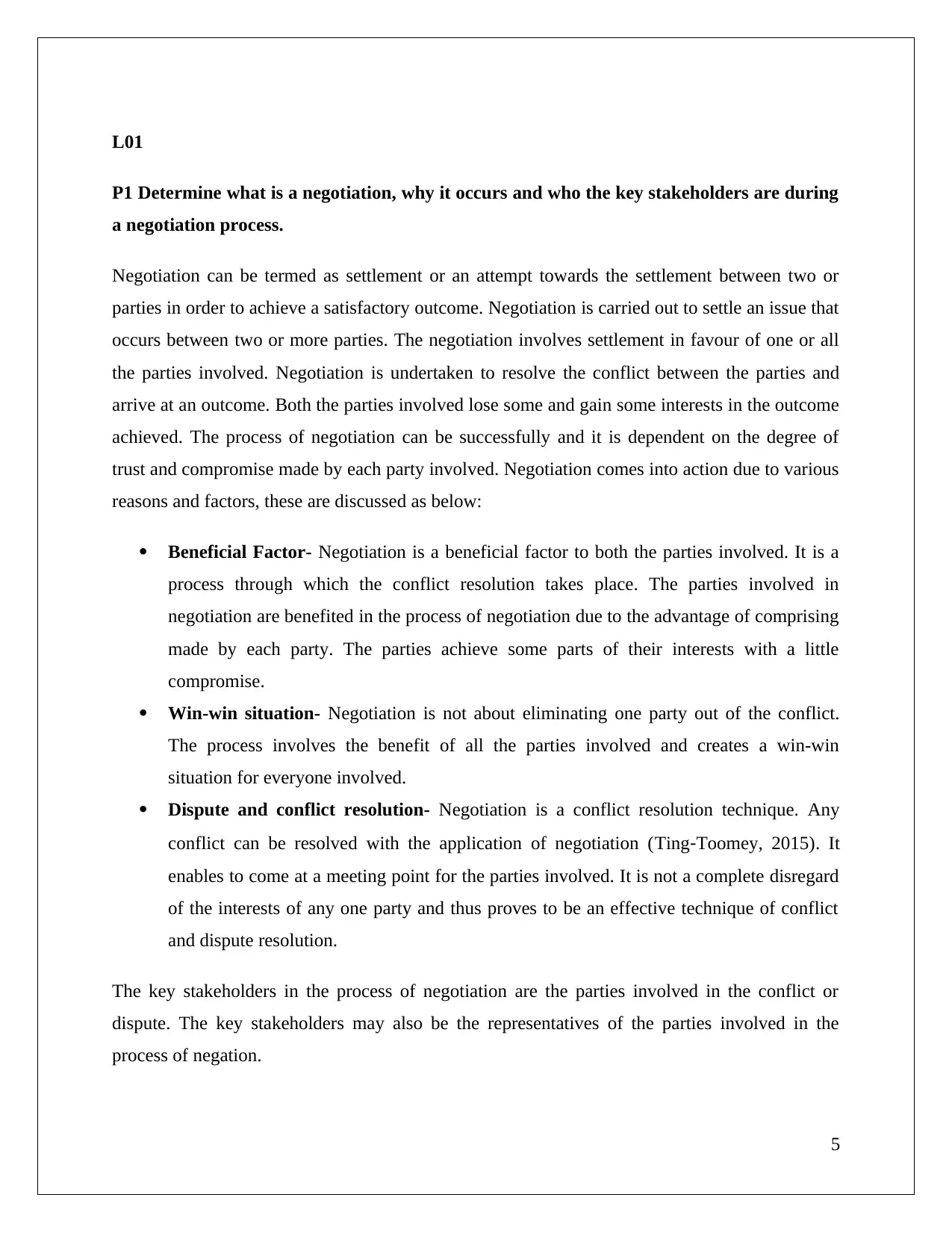
L01
P1 Determine what is a negotiation, why it occurs and who the key stakeholders are during
a negotiation process.
Negotiation can be termed as settlement or an attempt towards the settlement between two or
parties in order to achieve a satisfactory outcome. Negotiation is carried out to settle an issue that
occurs between two or more parties. The negotiation involves settlement in favour of one or all
the parties involved. Negotiation is undertaken to resolve the conflict between the parties and
arrive at an outcome. Both the parties involved lose some and gain some interests in the outcome
achieved. The process of negotiation can be successfully and it is dependent on the degree of
trust and compromise made by each party involved. Negotiation comes into action due to various
reasons and factors, these are discussed as below:
Beneficial Factor- Negotiation is a beneficial factor to both the parties involved. It is a
process through which the conflict resolution takes place. The parties involved in
negotiation are benefited in the process of negotiation due to the advantage of comprising
made by each party. The parties achieve some parts of their interests with a little
compromise.
Win-win situation- Negotiation is not about eliminating one party out of the conflict.
The process involves the benefit of all the parties involved and creates a win-win
situation for everyone involved.
Dispute and conflict resolution- Negotiation is a conflict resolution technique. Any
conflict can be resolved with the application of negotiation (Ting‐Toomey, 2015). It
enables to come at a meeting point for the parties involved. It is not a complete disregard
of the interests of any one party and thus proves to be an effective technique of conflict
and dispute resolution.
The key stakeholders in the process of negotiation are the parties involved in the conflict or
dispute. The key stakeholders may also be the representatives of the parties involved in the
process of negation.
5
P1 Determine what is a negotiation, why it occurs and who the key stakeholders are during
a negotiation process.
Negotiation can be termed as settlement or an attempt towards the settlement between two or
parties in order to achieve a satisfactory outcome. Negotiation is carried out to settle an issue that
occurs between two or more parties. The negotiation involves settlement in favour of one or all
the parties involved. Negotiation is undertaken to resolve the conflict between the parties and
arrive at an outcome. Both the parties involved lose some and gain some interests in the outcome
achieved. The process of negotiation can be successfully and it is dependent on the degree of
trust and compromise made by each party involved. Negotiation comes into action due to various
reasons and factors, these are discussed as below:
Beneficial Factor- Negotiation is a beneficial factor to both the parties involved. It is a
process through which the conflict resolution takes place. The parties involved in
negotiation are benefited in the process of negotiation due to the advantage of comprising
made by each party. The parties achieve some parts of their interests with a little
compromise.
Win-win situation- Negotiation is not about eliminating one party out of the conflict.
The process involves the benefit of all the parties involved and creates a win-win
situation for everyone involved.
Dispute and conflict resolution- Negotiation is a conflict resolution technique. Any
conflict can be resolved with the application of negotiation (Ting‐Toomey, 2015). It
enables to come at a meeting point for the parties involved. It is not a complete disregard
of the interests of any one party and thus proves to be an effective technique of conflict
and dispute resolution.
The key stakeholders in the process of negotiation are the parties involved in the conflict or
dispute. The key stakeholders may also be the representatives of the parties involved in the
process of negation.
5
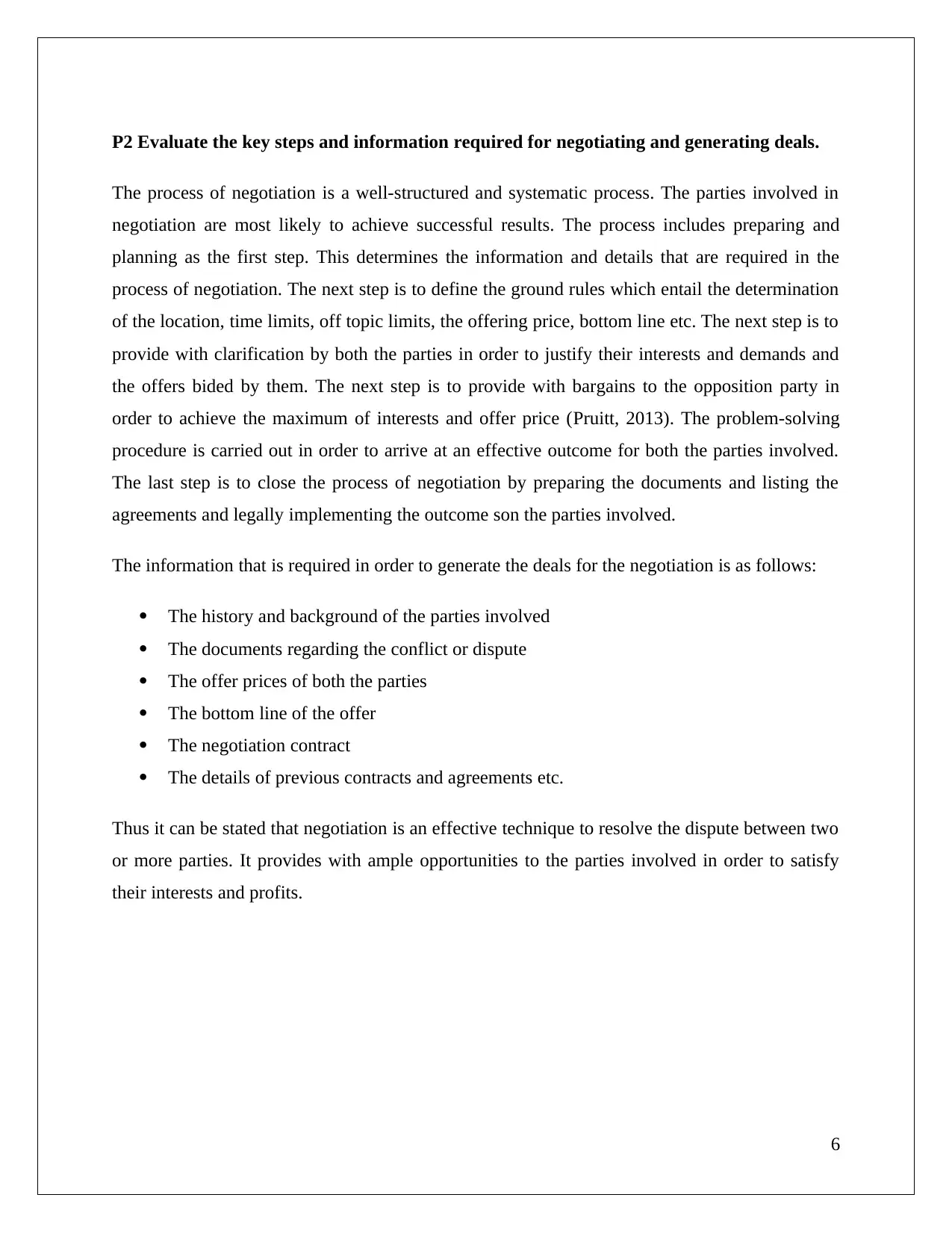
P2 Evaluate the key steps and information required for negotiating and generating deals.
The process of negotiation is a well-structured and systematic process. The parties involved in
negotiation are most likely to achieve successful results. The process includes preparing and
planning as the first step. This determines the information and details that are required in the
process of negotiation. The next step is to define the ground rules which entail the determination
of the location, time limits, off topic limits, the offering price, bottom line etc. The next step is to
provide with clarification by both the parties in order to justify their interests and demands and
the offers bided by them. The next step is to provide with bargains to the opposition party in
order to achieve the maximum of interests and offer price (Pruitt, 2013). The problem-solving
procedure is carried out in order to arrive at an effective outcome for both the parties involved.
The last step is to close the process of negotiation by preparing the documents and listing the
agreements and legally implementing the outcome son the parties involved.
The information that is required in order to generate the deals for the negotiation is as follows:
The history and background of the parties involved
The documents regarding the conflict or dispute
The offer prices of both the parties
The bottom line of the offer
The negotiation contract
The details of previous contracts and agreements etc.
Thus it can be stated that negotiation is an effective technique to resolve the dispute between two
or more parties. It provides with ample opportunities to the parties involved in order to satisfy
their interests and profits.
6
The process of negotiation is a well-structured and systematic process. The parties involved in
negotiation are most likely to achieve successful results. The process includes preparing and
planning as the first step. This determines the information and details that are required in the
process of negotiation. The next step is to define the ground rules which entail the determination
of the location, time limits, off topic limits, the offering price, bottom line etc. The next step is to
provide with clarification by both the parties in order to justify their interests and demands and
the offers bided by them. The next step is to provide with bargains to the opposition party in
order to achieve the maximum of interests and offer price (Pruitt, 2013). The problem-solving
procedure is carried out in order to arrive at an effective outcome for both the parties involved.
The last step is to close the process of negotiation by preparing the documents and listing the
agreements and legally implementing the outcome son the parties involved.
The information that is required in order to generate the deals for the negotiation is as follows:
The history and background of the parties involved
The documents regarding the conflict or dispute
The offer prices of both the parties
The bottom line of the offer
The negotiation contract
The details of previous contracts and agreements etc.
Thus it can be stated that negotiation is an effective technique to resolve the dispute between two
or more parties. It provides with ample opportunities to the parties involved in order to satisfy
their interests and profits.
6
⊘ This is a preview!⊘
Do you want full access?
Subscribe today to unlock all pages.

Trusted by 1+ million students worldwide
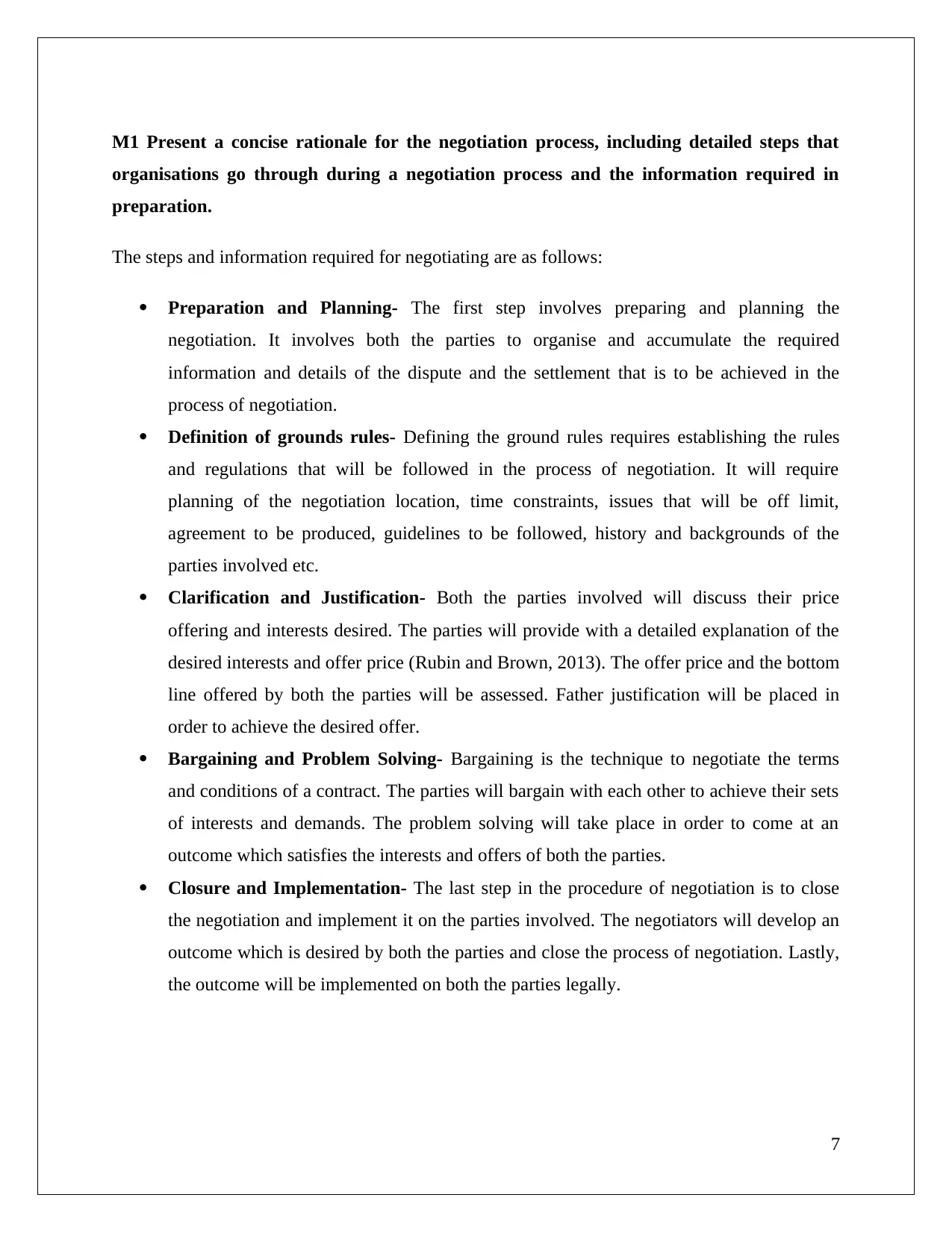
M1 Present a concise rationale for the negotiation process, including detailed steps that
organisations go through during a negotiation process and the information required in
preparation.
The steps and information required for negotiating are as follows:
Preparation and Planning- The first step involves preparing and planning the
negotiation. It involves both the parties to organise and accumulate the required
information and details of the dispute and the settlement that is to be achieved in the
process of negotiation.
Definition of grounds rules- Defining the ground rules requires establishing the rules
and regulations that will be followed in the process of negotiation. It will require
planning of the negotiation location, time constraints, issues that will be off limit,
agreement to be produced, guidelines to be followed, history and backgrounds of the
parties involved etc.
Clarification and Justification- Both the parties involved will discuss their price
offering and interests desired. The parties will provide with a detailed explanation of the
desired interests and offer price (Rubin and Brown, 2013). The offer price and the bottom
line offered by both the parties will be assessed. Father justification will be placed in
order to achieve the desired offer.
Bargaining and Problem Solving- Bargaining is the technique to negotiate the terms
and conditions of a contract. The parties will bargain with each other to achieve their sets
of interests and demands. The problem solving will take place in order to come at an
outcome which satisfies the interests and offers of both the parties.
Closure and Implementation- The last step in the procedure of negotiation is to close
the negotiation and implement it on the parties involved. The negotiators will develop an
outcome which is desired by both the parties and close the process of negotiation. Lastly,
the outcome will be implemented on both the parties legally.
7
organisations go through during a negotiation process and the information required in
preparation.
The steps and information required for negotiating are as follows:
Preparation and Planning- The first step involves preparing and planning the
negotiation. It involves both the parties to organise and accumulate the required
information and details of the dispute and the settlement that is to be achieved in the
process of negotiation.
Definition of grounds rules- Defining the ground rules requires establishing the rules
and regulations that will be followed in the process of negotiation. It will require
planning of the negotiation location, time constraints, issues that will be off limit,
agreement to be produced, guidelines to be followed, history and backgrounds of the
parties involved etc.
Clarification and Justification- Both the parties involved will discuss their price
offering and interests desired. The parties will provide with a detailed explanation of the
desired interests and offer price (Rubin and Brown, 2013). The offer price and the bottom
line offered by both the parties will be assessed. Father justification will be placed in
order to achieve the desired offer.
Bargaining and Problem Solving- Bargaining is the technique to negotiate the terms
and conditions of a contract. The parties will bargain with each other to achieve their sets
of interests and demands. The problem solving will take place in order to come at an
outcome which satisfies the interests and offers of both the parties.
Closure and Implementation- The last step in the procedure of negotiation is to close
the negotiation and implement it on the parties involved. The negotiators will develop an
outcome which is desired by both the parties and close the process of negotiation. Lastly,
the outcome will be implemented on both the parties legally.
7
Paraphrase This Document
Need a fresh take? Get an instant paraphrase of this document with our AI Paraphraser
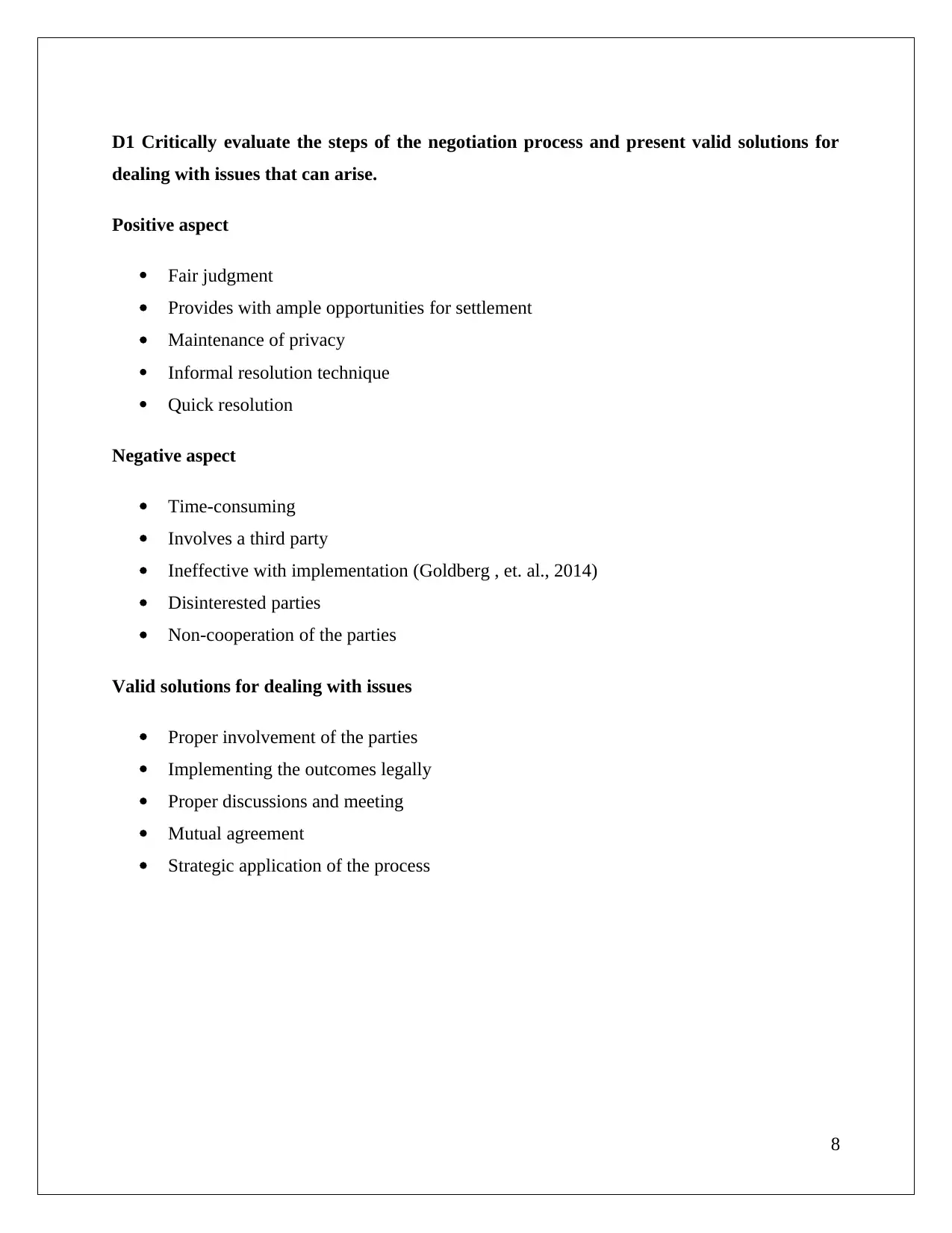
D1 Critically evaluate the steps of the negotiation process and present valid solutions for
dealing with issues that can arise.
Positive aspect
Fair judgment
Provides with ample opportunities for settlement
Maintenance of privacy
Informal resolution technique
Quick resolution
Negative aspect
Time-consuming
Involves a third party
Ineffective with implementation (Goldberg , et. al., 2014)
Disinterested parties
Non-cooperation of the parties
Valid solutions for dealing with issues
Proper involvement of the parties
Implementing the outcomes legally
Proper discussions and meeting
Mutual agreement
Strategic application of the process
8
dealing with issues that can arise.
Positive aspect
Fair judgment
Provides with ample opportunities for settlement
Maintenance of privacy
Informal resolution technique
Quick resolution
Negative aspect
Time-consuming
Involves a third party
Ineffective with implementation (Goldberg , et. al., 2014)
Disinterested parties
Non-cooperation of the parties
Valid solutions for dealing with issues
Proper involvement of the parties
Implementing the outcomes legally
Proper discussions and meeting
Mutual agreement
Strategic application of the process
8
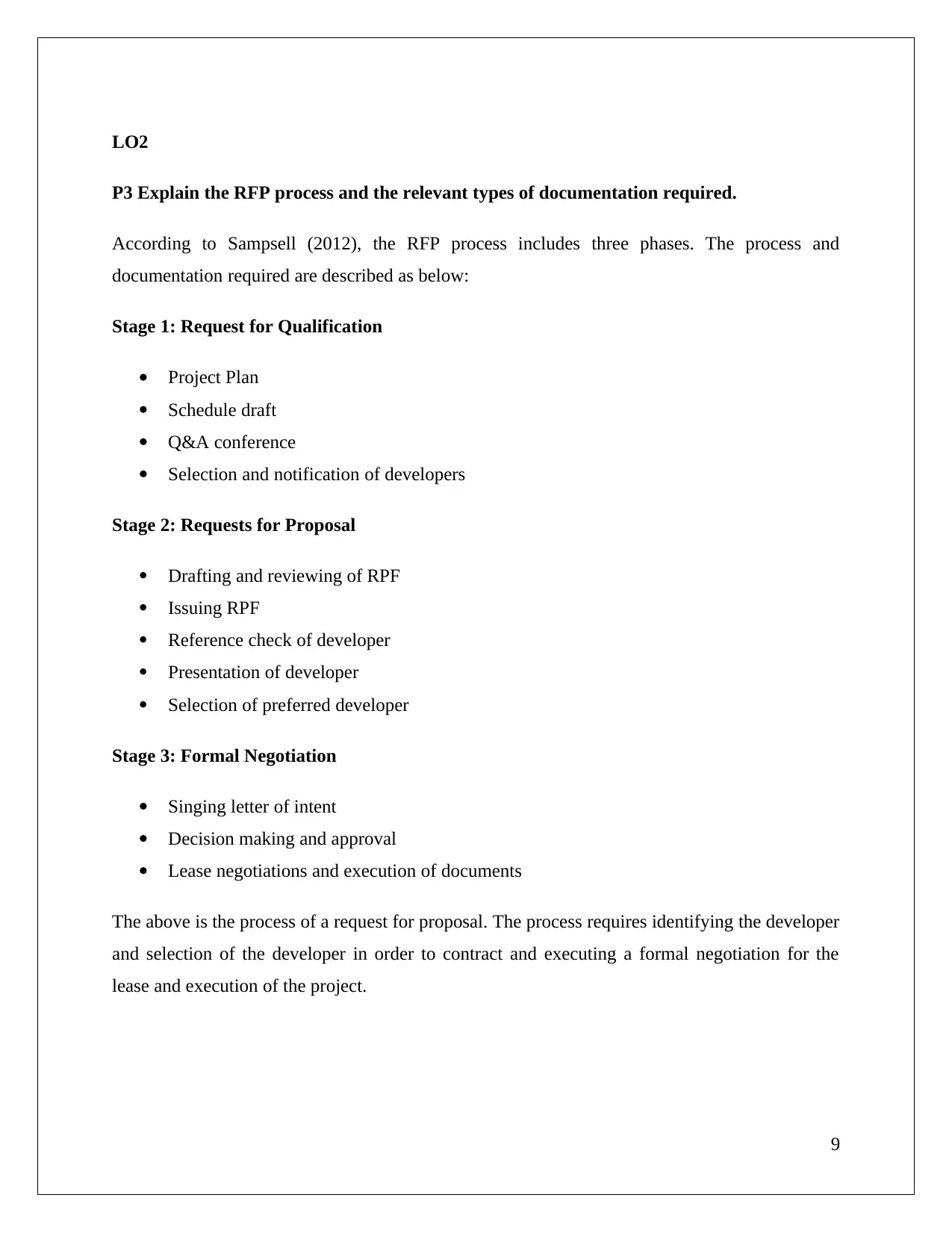
LO2
P3 Explain the RFP process and the relevant types of documentation required.
According to Sampsell (2012), the RFP process includes three phases. The process and
documentation required are described as below:
Stage 1: Request for Qualification
Project Plan
Schedule draft
Q&A conference
Selection and notification of developers
Stage 2: Requests for Proposal
Drafting and reviewing of RPF
Issuing RPF
Reference check of developer
Presentation of developer
Selection of preferred developer
Stage 3: Formal Negotiation
Singing letter of intent
Decision making and approval
Lease negotiations and execution of documents
The above is the process of a request for proposal. The process requires identifying the developer
and selection of the developer in order to contract and executing a formal negotiation for the
lease and execution of the project.
9
P3 Explain the RFP process and the relevant types of documentation required.
According to Sampsell (2012), the RFP process includes three phases. The process and
documentation required are described as below:
Stage 1: Request for Qualification
Project Plan
Schedule draft
Q&A conference
Selection and notification of developers
Stage 2: Requests for Proposal
Drafting and reviewing of RPF
Issuing RPF
Reference check of developer
Presentation of developer
Selection of preferred developer
Stage 3: Formal Negotiation
Singing letter of intent
Decision making and approval
Lease negotiations and execution of documents
The above is the process of a request for proposal. The process requires identifying the developer
and selection of the developer in order to contract and executing a formal negotiation for the
lease and execution of the project.
9
⊘ This is a preview!⊘
Do you want full access?
Subscribe today to unlock all pages.

Trusted by 1+ million students worldwide
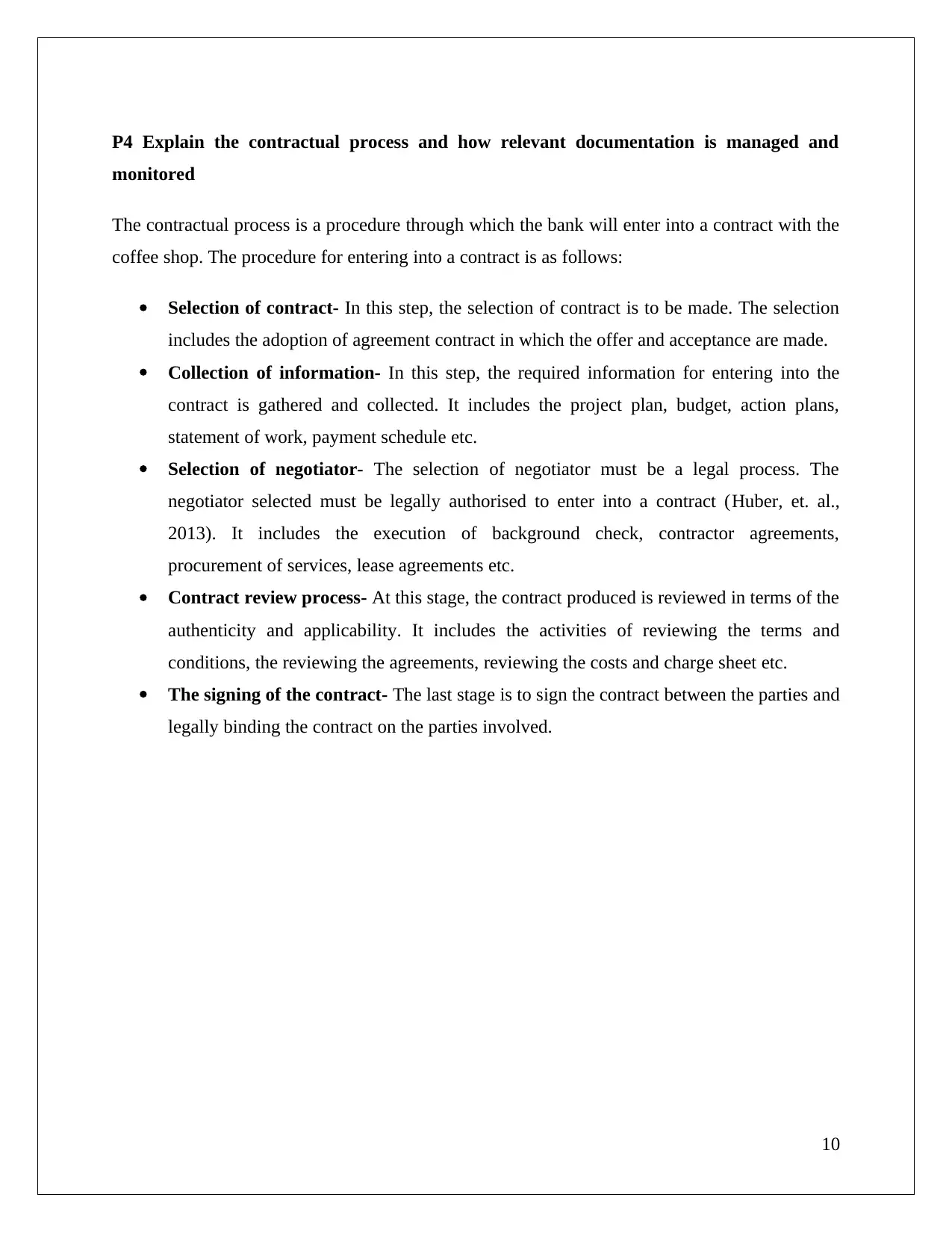
P4 Explain the contractual process and how relevant documentation is managed and
monitored
The contractual process is a procedure through which the bank will enter into a contract with the
coffee shop. The procedure for entering into a contract is as follows:
Selection of contract- In this step, the selection of contract is to be made. The selection
includes the adoption of agreement contract in which the offer and acceptance are made.
Collection of information- In this step, the required information for entering into the
contract is gathered and collected. It includes the project plan, budget, action plans,
statement of work, payment schedule etc.
Selection of negotiator- The selection of negotiator must be a legal process. The
negotiator selected must be legally authorised to enter into a contract (Huber, et. al.,
2013). It includes the execution of background check, contractor agreements,
procurement of services, lease agreements etc.
Contract review process- At this stage, the contract produced is reviewed in terms of the
authenticity and applicability. It includes the activities of reviewing the terms and
conditions, the reviewing the agreements, reviewing the costs and charge sheet etc.
The signing of the contract- The last stage is to sign the contract between the parties and
legally binding the contract on the parties involved.
10
monitored
The contractual process is a procedure through which the bank will enter into a contract with the
coffee shop. The procedure for entering into a contract is as follows:
Selection of contract- In this step, the selection of contract is to be made. The selection
includes the adoption of agreement contract in which the offer and acceptance are made.
Collection of information- In this step, the required information for entering into the
contract is gathered and collected. It includes the project plan, budget, action plans,
statement of work, payment schedule etc.
Selection of negotiator- The selection of negotiator must be a legal process. The
negotiator selected must be legally authorised to enter into a contract (Huber, et. al.,
2013). It includes the execution of background check, contractor agreements,
procurement of services, lease agreements etc.
Contract review process- At this stage, the contract produced is reviewed in terms of the
authenticity and applicability. It includes the activities of reviewing the terms and
conditions, the reviewing the agreements, reviewing the costs and charge sheet etc.
The signing of the contract- The last stage is to sign the contract between the parties and
legally binding the contract on the parties involved.
10
Paraphrase This Document
Need a fresh take? Get an instant paraphrase of this document with our AI Paraphraser
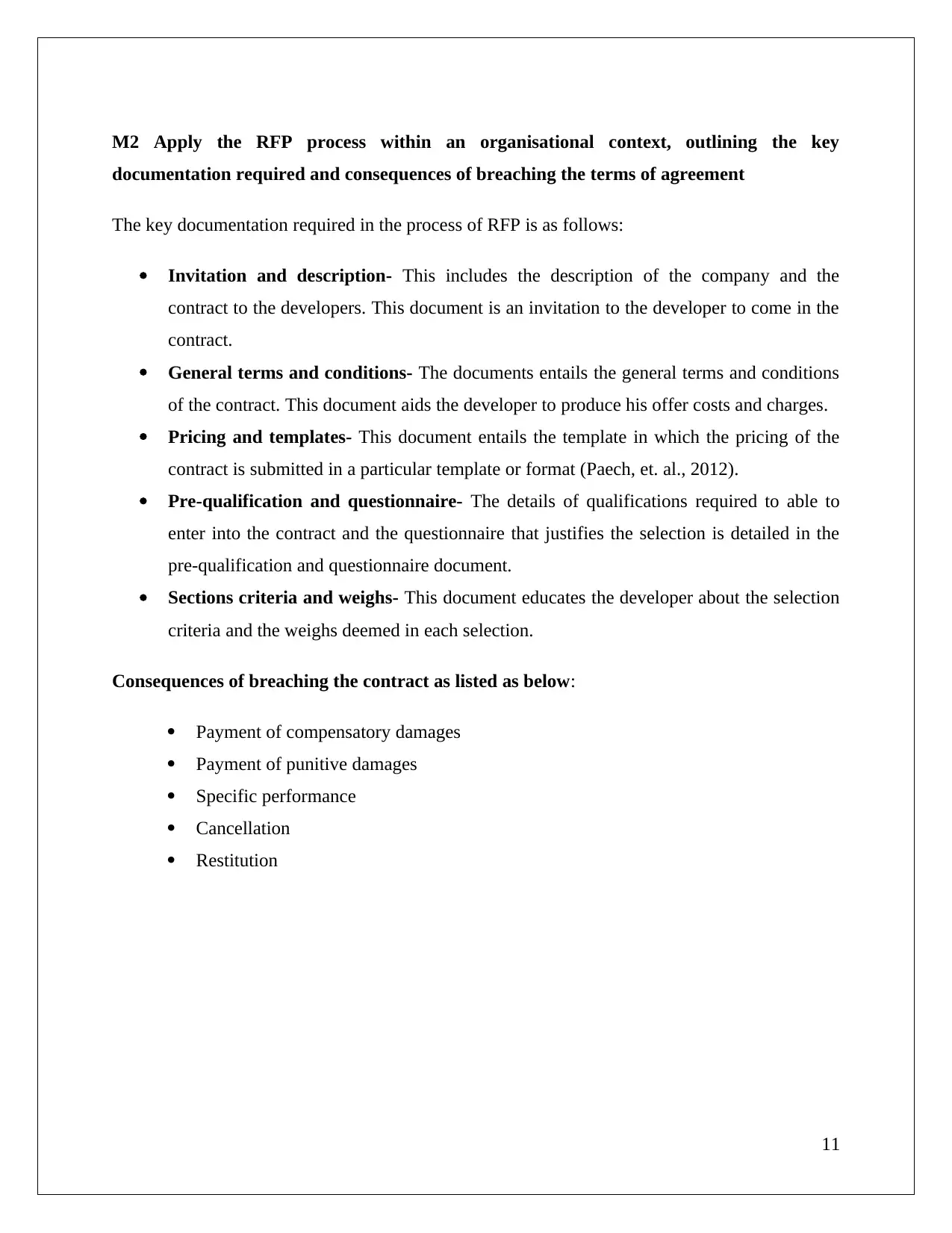
M2 Apply the RFP process within an organisational context, outlining the key
documentation required and consequences of breaching the terms of agreement
The key documentation required in the process of RFP is as follows:
Invitation and description- This includes the description of the company and the
contract to the developers. This document is an invitation to the developer to come in the
contract.
General terms and conditions- The documents entails the general terms and conditions
of the contract. This document aids the developer to produce his offer costs and charges.
Pricing and templates- This document entails the template in which the pricing of the
contract is submitted in a particular template or format (Paech, et. al., 2012).
Pre-qualification and questionnaire- The details of qualifications required to able to
enter into the contract and the questionnaire that justifies the selection is detailed in the
pre-qualification and questionnaire document.
Sections criteria and weighs- This document educates the developer about the selection
criteria and the weighs deemed in each selection.
Consequences of breaching the contract as listed as below:
Payment of compensatory damages
Payment of punitive damages
Specific performance
Cancellation
Restitution
11
documentation required and consequences of breaching the terms of agreement
The key documentation required in the process of RFP is as follows:
Invitation and description- This includes the description of the company and the
contract to the developers. This document is an invitation to the developer to come in the
contract.
General terms and conditions- The documents entails the general terms and conditions
of the contract. This document aids the developer to produce his offer costs and charges.
Pricing and templates- This document entails the template in which the pricing of the
contract is submitted in a particular template or format (Paech, et. al., 2012).
Pre-qualification and questionnaire- The details of qualifications required to able to
enter into the contract and the questionnaire that justifies the selection is detailed in the
pre-qualification and questionnaire document.
Sections criteria and weighs- This document educates the developer about the selection
criteria and the weighs deemed in each selection.
Consequences of breaching the contract as listed as below:
Payment of compensatory damages
Payment of punitive damages
Specific performance
Cancellation
Restitution
11
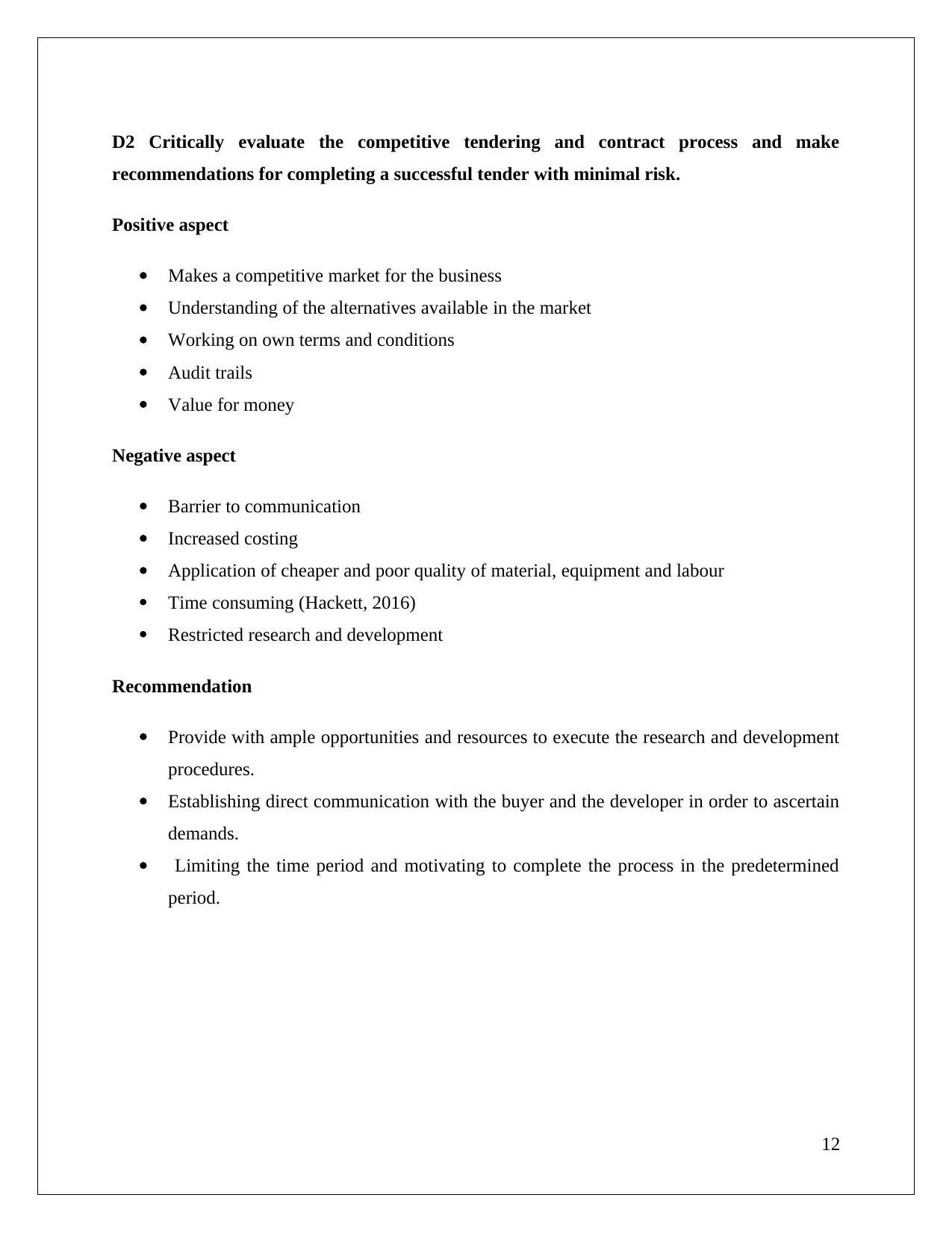
D2 Critically evaluate the competitive tendering and contract process and make
recommendations for completing a successful tender with minimal risk.
Positive aspect
Makes a competitive market for the business
Understanding of the alternatives available in the market
Working on own terms and conditions
Audit trails
Value for money
Negative aspect
Barrier to communication
Increased costing
Application of cheaper and poor quality of material, equipment and labour
Time consuming (Hackett, 2016)
Restricted research and development
Recommendation
Provide with ample opportunities and resources to execute the research and development
procedures.
Establishing direct communication with the buyer and the developer in order to ascertain
demands.
Limiting the time period and motivating to complete the process in the predetermined
period.
12
recommendations for completing a successful tender with minimal risk.
Positive aspect
Makes a competitive market for the business
Understanding of the alternatives available in the market
Working on own terms and conditions
Audit trails
Value for money
Negative aspect
Barrier to communication
Increased costing
Application of cheaper and poor quality of material, equipment and labour
Time consuming (Hackett, 2016)
Restricted research and development
Recommendation
Provide with ample opportunities and resources to execute the research and development
procedures.
Establishing direct communication with the buyer and the developer in order to ascertain
demands.
Limiting the time period and motivating to complete the process in the predetermined
period.
12
⊘ This is a preview!⊘
Do you want full access?
Subscribe today to unlock all pages.

Trusted by 1+ million students worldwide
1 out of 21
Related Documents
Your All-in-One AI-Powered Toolkit for Academic Success.
+13062052269
info@desklib.com
Available 24*7 on WhatsApp / Email
![[object Object]](/_next/static/media/star-bottom.7253800d.svg)
Unlock your academic potential
Copyright © 2020–2025 A2Z Services. All Rights Reserved. Developed and managed by ZUCOL.




